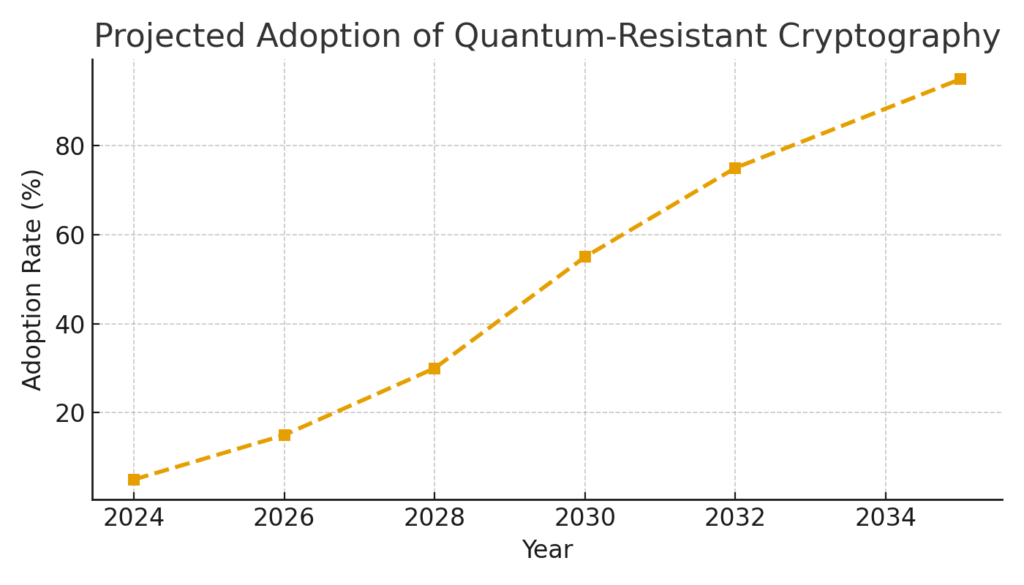
Key Points :
- Renowned bitcoin analyst Willy Woo recommends migrating funds from Taproot (bc1p…) addresses to earlier-format SegWit (bc1q…) addresses and holding them there for roughly 7 years, until a quantum-safe protocol is fully deployed.
- The core threat: quantum computers may one day use algorithms (such as Shor’s algorithm) to derive private keys from exposed public keys, thereby undermining the elliptic-curve cryptography (ECDSA) underpinning Bitcoin.
- SegWit addresses conceal public keys until the first outgoing transaction, whereas Taproot addresses embed or reveal the public key earlier — making Taproot addresses relatively more vulnerable under a quantum-attack scenario.
- The broader bitcoin community remains divided: some experts (e.g., Charles Edwards) argue SegWit is not a quantum-safe model at all and that waiting years without a hard-fork for quantum-resistant cryptography places the network at risk.
- Research indicates the “quantum threat” is real but not immediate — many projections suggest a relevant quantum computer capable of breaking current cryptography might appear between 2028 and 2035 — meaning now is the time to prepare.
- For practical blockchain and crypto-asset investors seeking new assets, income opportunities, or real-world applications, this discussion highlights that the underlying infrastructure (wallet formats, key management, network upgrades) matters almost as much as token selection.
1. Understanding the Quantum Threat to Bitcoin
1.1 Why quantum computers worry the crypto world
The security model of Bitcoin relies substantially on elliptic-curve digital-signature algorithms (ECDSA) and related public-key cryptographic primitives. In essence: a user broadcasts a public key (or a hash of it) which allows signature verification; the private key remains secret and secures access to funds. A sufficiently powerful quantum computer can, in theory, run Shor’s algorithm to invert discrete-logarithm problems — meaning one day the public key might directly lead to the private key.
In addition, the “harvest now, decrypt later” model has been raised: attackers might record public keys now and wait until quantum hardware matures to extract the private keys and steal funds.
Thus, while the threat is not immediate, the time to act is earlier than one might think — especially for assets you intend to hold long-term without moving.
1.2 How address formats relate to the vulnerability

The exposure arises when a Bitcoin address publishes or reveals the public key on-chain — that moment gives quantum machines a target. For example:
- Legacy address types (starting “1” or “3”) and SegWit addresses (“bc1q…”) hide the public key behind a hash until a spend occurs. Thus, for unspent outputs, the public key remains hidden.
- By contrast, Taproot addresses (starting “bc1p…”) may embed or make public keys accessible earlier — meaning more exposure to a quantum adversary. According to Willy Woo’s analysis, Taproot is relatively more vulnerable.
Therefore, simply by choosing or migrating to a format which hides the public key longer, one may delay exposure.
1.3 The projected time-horizon and network upgrade imperative
There is broad consensus that a quantum computer capable of undermining Bitcoin’s cryptography could emerge sometime between 2028 and 2035 — one paper even suggests as early as March 2028. At the same time, transitioning an entire network like Bitcoin to a post-quantum signature algorithm is non-trivial: the literature estimates “downtime required” just for migration might be ~76 days of network interruption in the worst case.
The bottom line: waiting until the moment of crisis is too late. Upgrades must begin now.
2. Willy Woo’s Proposed Interim Strategy: “SegWit for ~7 Years”
2.1 The core of the proposal
Willy Woo recommends the following approach:
- Create or use a wallet with a SegWit address format (which typically begins with “bc1q…”) rather than the newer Taproot format (“bc1p…”).
- Transfer your Bitcoin holdings into that SegWit address and do not spend them from that address until a full quantum-safe protocol is ready. The act of spending would expose the public key and thus reintroduce vulnerability.
- Treat this as a temporary holding strategy—the purpose is to “buy time,” likely a period of about 7 years, during which the network and ecosystem transition to quantum-safe cryptography.
2.2 Why this strategy might appeal to long-term holders and crypto investors
For investors or institutions holding large amounts of Bitcoin (or who plan to hold for many years), the idea of minimising key-exposure risk is relevant. This strategy may serve as one piece of a broader asset-defence approach:
- By choosing a wallet format with lower exposure, you reduce the “attack surface” from future quantum computing threats.
- If you are focusing on new assets, yield opportunities or real-world blockchain deployments, this highlights the need to audit not just tokenomics but infrastructure — wallet formats, custody models, key-rotation plans.
- It signals that blockchain security is not static: we must plan for “beyond classical computers” risk. That is relevant to emerging assets, protocols and institutional custody strategies.
2.3 The limitations and caveats
However, this approach is not a panacea. As critics point out:
- SegWit is not truly quantum-safe—once you spend from the address, the public key becomes visible, reintroducing risk.
- A few experts argue that relying on a 7-year buffer gives a false sense of safety and delays the necessary protocol-level upgrade. Charles Edwards argued: “SegWit is no protection model. We need to upgrade the network ASAP.”
- The burden lies with the entire network, not only individual holders: without a consensus upgrade to quantum-resistant cryptography, the whole ecosystem remains exposed.
- For traders or frequent users, the “don’t spend” condition is impractical; holding funds passively for years might not align with their strategy.
3. Implications for Crypto Investors, Protocol Developers and New Asset Seekers
3.1 For investors seeking new crypto assets and yield
- When evaluating a new asset or platform, check whether its cryptography is post-quantum aware — e.g., uses or plans to use post-quantum digital–signature algorithms (PQSAs) or quantum-resistant key-schemes.
- Consider custody strategy: how the asset is held, how keys are managed, and whether the protocol supports or plans for post-quantum upgrades.
- In an “asset defence” mindset (which you indicated an interest in), this quantum risk frames how you might allocate: holding some assets in legacy “quieter” formats, rotating keys periodically, selecting assets built already with quantum resistance.
3.2 For protocol engineers and wallet developers
- If you’re working on wallets (as your project indicates), you should factor in: support for address-formats that minimise public-key exposure, key-rotation workflows, and potentially migration to post-quantum signature schemes.
- For EVM or EVM-compatible chains, you might embed alerts or tools that guide users about future cryptographic upgrades.
- Your pipeline (SNS integration / wallet UI) could provide educational prompts: e.g., “Your address format is classical-only; migrate or rotate keys for future proofing.”
- From a UX perspective: balancing “ease of use” with “secure long-term storage” may become a differentiator.
3.3 For the broader blockchain ecosystem and network operators
- The network must eventually adopt quantum-resistant cryptography (“PQC”) for signatures. The literature shows that there are PQC digital-signature alternatives (ML-DSA, Dilithium, Falcon, etc.) that are being benchmarked.
- Coordinating a network-wide upgrade is complex: it involves consensus, hard-forking, wallet-support, node-software update, etc. The paper on “Downtime Required for Bitcoin Quantum-Safety” indicates significant logistics.
- For new chains or protocols being built now, designing from day one for quantum resistance is far easier than retrofitting later. This could become a competitive edge.
4. Recent Developments & Trends Worth Watching

4.1 “Quantum Doomsday Clock” moves timelines earlier
A new online tool, the “Quantum Doomsday Clock,” estimates a date around March 8 2028 when a cryptographically-relevant quantum computer might begin to jeopardise Bitcoin private keys. Although this model is speculative and conservative opinions place that horizon further out, it signals increasing urgency.
For investors and developers, this means the “quantum risk event” cannot be assumed to be decades away – rather a window of ~2-7 years is being discussed.
4.2 Industry attention on quantum-safe cryptography

There is growing academic & industry work on post-quantum cryptography (PQC): as shown in the recent study benchmarking PQC algorithms in blockchain settings (ML-DSA, Dilithium, etc.). Also, blockchain-specific research emphasises that migrating classical networks to quantum-safe protocols must start before quantum attacks become feasible.
For anyone entering the crypto space now (whether asset issuer, wallet provider, or investor), quantum readiness may shift from “nice to have” to premium differentiator.
4.3 Community split on urgency vs. practicality
As noted earlier, some participants urge immediate hard-fork action; others view quantum threats as exaggerated or distant. For example, some believe mainstream financial institutions or classical systems will be attacked first, giving Bitcoin a “grace period.”
This split creates an opportunity: those who prepare early may gain both risk-reduction and competitive advantage. On the flip side, others may discount the risk — which could leave them exposed.
4.4 Asset-specific opportunities: Quantum-resistant platforms
An interesting niche is the category of blockchains built explicitly for quantum resistance (e.g., Quantum Resistant Ledger (QRL) uses the XMSS scheme). For investors looking for “next-new” assets, quantum-resistant-native chains may become a differentiator.
Nonetheless: one must perform standard due diligence (team, tokenomics, real use-case) — quantum resistance alone isn’t sufficient.
5. Practical Checklist for Crypto Investors & Custodians
Here is a summary checklist tailored for your audience (seeking new assets, income opportunities, practical blockchain use):
- Audit your current Bitcoin (and other crypto) holdings: which address formats are being used? Are public keys already exposed?
- If holding long-term (multi-year), consider migrating to SegWit format (“bc1q…”), especially for funds you plan not to transact for years.
- Ensure any future transfers from those addresses are timed deliberately – remember: spending the UTXO reveals the public key and resets the “safe” status.
- For new asset investments: verify that the protocol supports quantum-resistance (or has roadmap for PQC).
- For wallet design or custody solutions: embed user-education about quantum-key-exposure, rotation policies, address-format risk.
- Monitor network-level upgrade proposals for quantum-resistant signature schemes in major chains (e.g., Bitcoin, Ethereum, etc.).
- Finally: treat quantum risk as part of your “asset-defence” strategy (as you indicated your interest), alongside other risks (regulatory, smart-contract, liquidity). It may not yield immediate returns, but readiness may pay off if the quantum horizon accelerates.
6. Summary and Conclusion
In summary:
The emerging quantum computing threat to Bitcoin and similar cryptocurrencies is moving from academic speculation into actionable territory. While no commercially-relevant quantum computer has yet undermined Bitcoin’s cryptography, research, modelling and expert commentary all point to a risk window perhaps within the next 5-10 years.
Willy Woo’s proposal—moving holdings to SegWit address formats and waiting roughly seven years until a full quantum-safe upgrade is available—offers a pragmatic interim strategy for long-term holders. However, it is not a complete solution: the network itself must eventually upgrade to quantum-resistant cryptography, and individual strategy must account for edge-cases (such as spending from the address exposing keys).
For those seeking new crypto assets, yield opportunities and real-world blockchain application, this quantum layer adds another dimension of due diligence: wallet/key infrastructure, cryptographic schema, network upgrade readiness. It also creates potential new opportunities — projects and chains that embed quantum resistance from the start may gain traction.
Ultimately: this is one of those “silent infrastructure risks” that doesn’t dominate headlines yet but may radically affect holdings, custody models and protocol design. For investors, wallet builders, and protocol developers alike, the time to act is not when the quantum attack happens — it’s now.

